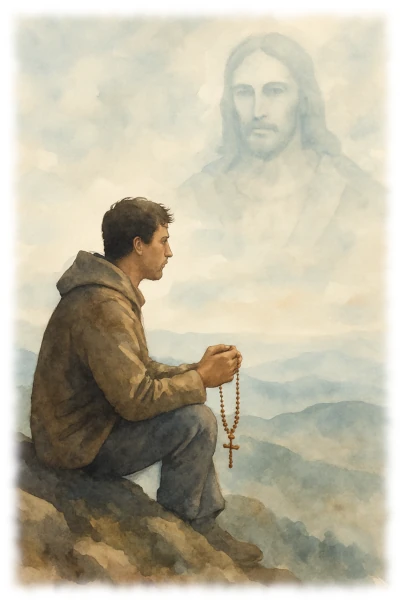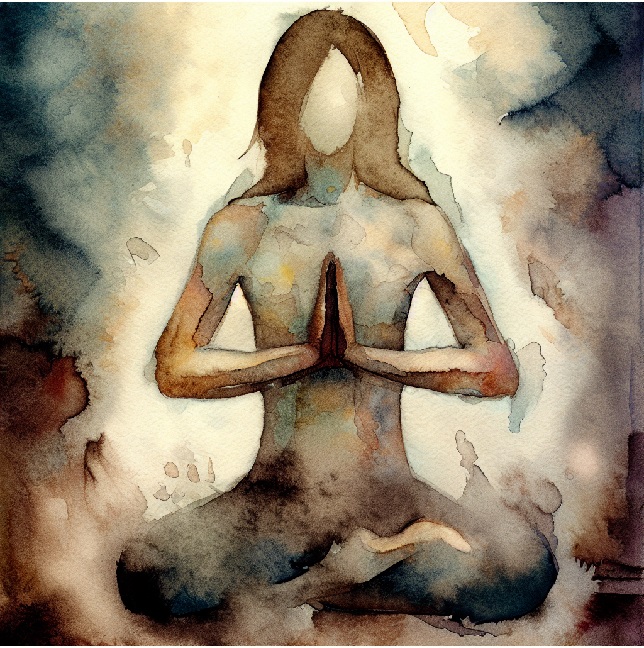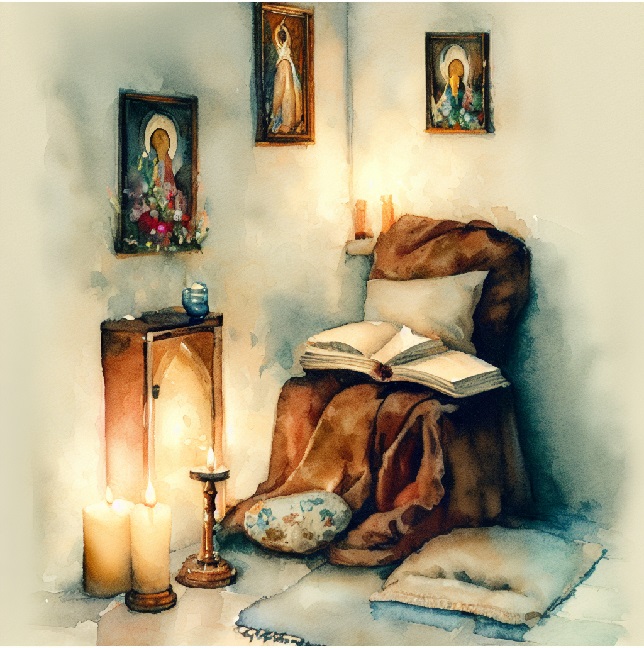- Rosary
- spiritual meditation
- Contemplative Meditation
Contemplative Meditation
Introduction to
Contemplative Meditation

Contemplative meditation is not just quiet thinking or even deep focus. It’s prayer that draws the soul inward—toward the presence of God—where words begin to fall away, and only love remains. Saints like St. Teresa of Avila described it as a form of prayer where the heart simply rests in God, sometimes without even needing to speak.
As I’ve journeyed deeper into praying the Rosary, especially during longer devotions like the 54-day Rosary Novena, I’ve noticed something change. At first, I’m saying the prayers aloud or silently with intention. But over time, there are moments when only my lips are moving—while my spirit feels completely wrapped in a quiet, loving awareness of Christ. It’s like the prayer carries me beyond the words, into something deeper.
This is what contemplative meditation feels like for me: a space where God meets me in silence, where love and grace begin to transform the heart. It’s not something I force or even always expect—it simply comes when I slow down, open myself, and stay present with the mystery of His love.
“Contemplative prayer, in my opinion, is nothing other than a close sharing between friends; it means taking time frequently to be alone with Him who we know loves us.”
— St. Teresa of Avila, The Book of Her Life
Personal Practices and Insights

Over time, I’ve come to see that contemplative meditation isn’t something I add to my prayer—it grows out of prayer. Especially when I pray the Rosary slowly and with attention, something deeper starts to happen. It doesn’t happen every time, but when it does, it’s unmistakable. There’s a sense of stillness, like God is gently drawing my heart inward, helping me see with more love and less fear.
One of the most meaningful times for this is early in the morning, when the house is quiet and the day hasn’t yet begun. During these moments, I sit with my Rosary, not rushing through the prayers, but letting each Hail Mary become a step into silence. Sometimes, I find that I’m no longer consciously thinking about the mysteries—yet somehow I’m there, present with Jesus, feeling His sorrow, love, or peace in a way that’s hard to describe. It’s transforming—divinely transforming.
These are not experiences I plan or chase. They come when I simply show up to prayer with a willing heart. I believe that’s the grace of contemplative prayer: God meets us where we are, and gently draws us closer to Himself.
“The important thing is not to think much, but to love much; and so do that which best stirs you to love.”
— St. Teresa of Avila, The Interior Castle
When God Draws Near
There are moments in prayer when something sacred begins to happen—quietly, gently, without any effort of my own. I often sit still with the Rosary in my hands, holding the crucifix between my fingers, letting God know I’m here. I'm listening—with open ears and an open heart.
As I focus on His presence and try to quiet the noise inside me, I sometimes feel my whole body settle, like the weight of the world has been set down. A calm warmth surrounds me—not dramatic, but steady and peaceful. And then, without warning, I take a deep breath. It isn’t something I try to do. It just happens. It feels like a sign that I’ve entered into something deeper, that I’m truly present, not just in body but in spirit.
These are moments I don’t control and can never predict. But they seem to come when I’m most willing to simply be with God—not rushing, not asking, just resting in trust. For me, that’s where contemplative meditation begins.
“It is love alone that gives worth to all things.”
— St. Teresa of Avila
🌿 Reflection: Entering the Silence
Find a quiet place. Sit still and take a moment to breathe. Hold your Rosary gently in your hands. You don’t need to start praying right away—just be still.
In your heart, say to God:
“Lord, I’m here. I’m listening. I bring no words, only my heart. Teach me to rest in Your presence.”
Focus on the cross. Let your thoughts slow down. Don’t worry about doing it “right.” Just stay present.
If your mind wanders, gently return to the stillness. If all you can do is sit quietly, that is enough. God knows you are there—and that alone is prayer.
Combining the
Rosary with the Stations
As my prayer life has grown, I’ve found that praying the Rosary while reflecting on the Stations of the Cross creates a deep, powerful connection to the life, suffering, and love of Jesus. These two devotions, though different in form, speak to each other in a way that draws my heart into deeper contemplation.
For example, when I pray the Sorrowful Mysteries, I often pair each one with a Station of the Cross. While meditating on the Scourging at the Pillar, I reflect on Station Two, where Jesus takes up His cross. As I pray, I imagine the weight of the wood, the pain of the blows, and the love that carried Him forward. This helps me not only understand the mystery but feel it in my soul.
One of the most moving pairings is praying the Crucifixion (the Fifth Sorrowful Mystery) while reflecting on Station Twelve—Jesus dies on the cross. In these moments, I often find myself in silence, holding the Rosary close, overwhelmed by His sacrifice. The prayers become more than words—they become a doorway into the Passion of Christ.
This way of praying isn’t about doing more—it’s about going deeper. Letting the Rosary guide you through the Stations allows the heart to slow down and truly enter into the mystery of God's love and mercy.
“Let us meditate… and strive to imitate His virtues, especially His patience and humility.”
— St. Alphonsus Liguori, The Way of the Cross
Suggested Pairings:
Sorrowful Mysteries & Stations of the Cross
The Agony in the Garden
-- Station I Jesus is Condemned to Death
-- Jesus Surrenders to the Father's will, beginning His Passion
The Scourging at the Pillar
-- Station II Jesus Takes Up His Cross after being scourged
-- Jesus accepts the Cross and the path of suffering
The Crowning of Thorns
-- Station III Jesus Falls the First Time
-- The Weight of humiliation and pain begins to take its toll
The Carrying of the Cross
-- Station V Simon Helps Jesus Carry His Cross
-- The journey becomes too heavy, and help is given along the way
The Crucifixion and Death
-- Station XII Jesus Dies on the Cross
-- A moment to pause in reverence for His sacrifice, love and final breath
🕊️ You don’t need to do this all at once. Choose one pairing a day or during a Holy Hour.
Let the Holy Spirit lead your heart into the mystery.
Encouragement for the Reader

If you’ve ever felt drawn to go deeper in prayer but didn’t know how let this be your invitation. Contemplative meditation doesn’t require anything fancy or complicated. It begins with a willing heart, a little silence, and trust that God will meet you there.
Start small. Maybe it’s five quiet minutes in the morning with your Rosary. Maybe it’s one pairing of a Mystery and a Station that stays with you all day. Let it become a gentle rhythm in your life—something you return to, not out of obligation, but because your soul begins to crave that stillness with God.
You might find it helpful to make this time a personal ritual. Light a candle, hold your favorite Rosary, or sit in a special corner of your home. After prayer, you can write down your thoughts or feelings in a spiritual journal. Sometimes I jot down just a phrase, a word, or a sense I had during the prayer. Over time, these small reflections become a beautiful record of grace at work in your life.
Also, don’t hesitate to explore other spiritual works that inspire you—writings from saints like St. Teresa of Avila, St. John of the Cross, or St. Alphonsus Liguori can be wonderful companions on the contemplative path.
Most of all, be gentle with yourself. This journey is not about performance—it’s about presence. God desires your heart, not perfection.
🌿 Explore Contemplative Arts
If you're looking to deepen your prayer life through creative expression, consider exploring our Contemplative Arts page.
Here, you'll find resources and inspiration for integrating journaling, sacred art, and other spiritual practices into your daily routine. These tools can help you connect more profoundly with your faith and enhance your contemplative meditation journey.


